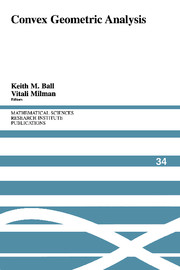Book contents
- Frontmatter
- Contents
- Introduction: The Convex Geometry and Geometric Analysis Program MSRI, Spring 1996
- Msri Program Seminars
- Integrals of Smooth and Analytic Functions over Minkowski's Sums of Convex Sets
- Localization Technique on the Sphere and the Gromov-Milman Theorem on the Concentration Phenomenon on Uniformly Convex Sphere
- Geometric Inequalities in Option Pricing
- Random Points in Isotropic Convex Sets
- Threshold Intervals under Group Symmetries
- On a Generalization of the Busemann-Petty Problem
- Isotropic Constants of Schatten Class Spaces
- On the Stability of the Volume Radius
- Polytope Approximations of the Unit Ball of ℓnp
- A Remark about the Scalar-Plus-Compact Problem
- Another Low-Technology Estimate in Convex Geometry
- On the Equivalence Between Geometric and Arithmetic Means for Log-Concave Measures
- On the Constant in the Reverse Brunn-Minkowski Inequality for p-Convex Balls
- The Extension of the Finite-Dimensional Version of Krivine's Theorem to Quasi-Normed Spaces
- A Note on Gowers' Dichotomy Theorem
- An "Isomorphic" Version of Dvoretzky's Theorem, II
- Asymptotic Versions of Operators and Operator Ideals
- Metric Entropy of the Grassmann Manifold
- Curvature of Nonlocal Markov Generators
- An Extremal Property of the Regular Simplex
- Floating Body, Illumination Body, and Polytopal Approximation
- A Note on the M*-Limiting Convolution Body
Floating Body, Illumination Body, and Polytopal Approximation
Published online by Cambridge University Press: 27 June 2025
- Frontmatter
- Contents
- Introduction: The Convex Geometry and Geometric Analysis Program MSRI, Spring 1996
- Msri Program Seminars
- Integrals of Smooth and Analytic Functions over Minkowski's Sums of Convex Sets
- Localization Technique on the Sphere and the Gromov-Milman Theorem on the Concentration Phenomenon on Uniformly Convex Sphere
- Geometric Inequalities in Option Pricing
- Random Points in Isotropic Convex Sets
- Threshold Intervals under Group Symmetries
- On a Generalization of the Busemann-Petty Problem
- Isotropic Constants of Schatten Class Spaces
- On the Stability of the Volume Radius
- Polytope Approximations of the Unit Ball of ℓnp
- A Remark about the Scalar-Plus-Compact Problem
- Another Low-Technology Estimate in Convex Geometry
- On the Equivalence Between Geometric and Arithmetic Means for Log-Concave Measures
- On the Constant in the Reverse Brunn-Minkowski Inequality for p-Convex Balls
- The Extension of the Finite-Dimensional Version of Krivine's Theorem to Quasi-Normed Spaces
- A Note on Gowers' Dichotomy Theorem
- An "Isomorphic" Version of Dvoretzky's Theorem, II
- Asymptotic Versions of Operators and Operator Ideals
- Metric Entropy of the Grassmann Manifold
- Curvature of Nonlocal Markov Generators
- An Extremal Property of the Regular Simplex
- Floating Body, Illumination Body, and Polytopal Approximation
- A Note on the M*-Limiting Convolution Body
Summary
Let K be a convex body in IRd and K t its floating bodies. There is a polytope that satisfies Kt ⊂ Pn ⊂ K and has at most n vertices, where
Let Kt be the illumination bodies of K and Qn a polytope that contains K and has at most n (d-1)-dimensional faces.
1. Introduction
We investigate the approximation of a convex body K in Rd by a polytope. We measure the approximation by the symmetric difference metric. The symmetric difference metric between two convex bodies K and C is
We study in particular two questions: How well can a convex body K be approximated by a polytope Pn that is contained in K and has at most n vertices and how well can K be approximated by a polytope Qn that contains K and has at most n (d-1)-dimensional faces. Macbeath [Mac] showed that the Euclidean Ball Bd2 is an extremal case: The approximation for any other convex body is better. We have for the Euclidean ballprovided that n ≥ (C3 d)(d-1)/2. The right hand inequality was first established by Bronshtein and Ivanov [BI] and Dudley [D1,D2]. Gordon, Meyer, and Reisner [GMR1,GMR2] gave a constructive proof for the same inequality. Muller [Mü] showed that random approximation gives the same estimate. Gordon, Reisner, and Schutt [GRS] established the left hand inequality. Gruber [Gr2] obtained an asymptotic formula.
Information
- Type
- Chapter
- Information
- Convex Geometric Analysis , pp. 203 - 230Publisher: Cambridge University PressPrint publication year: 1999
